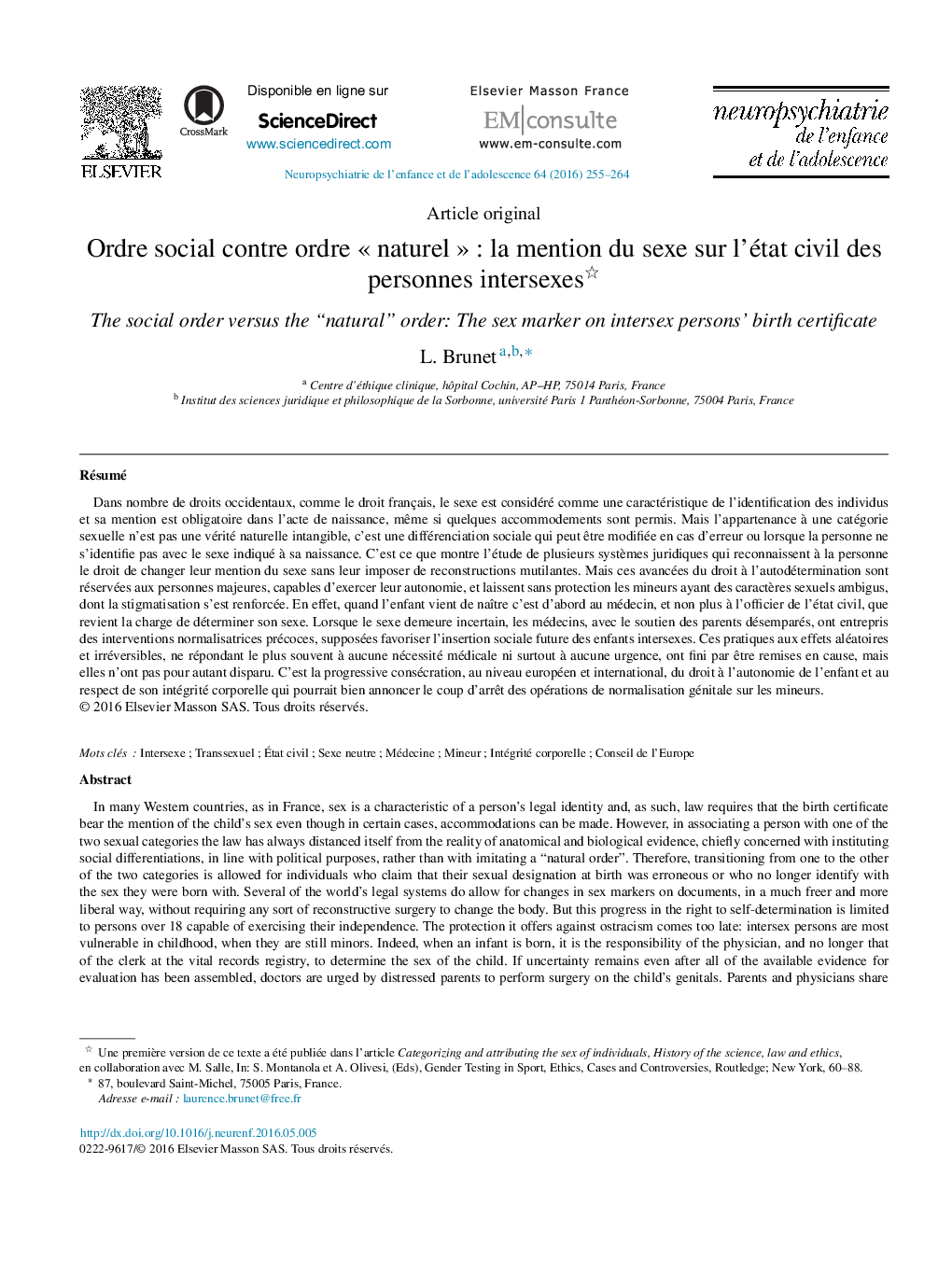| کد مقاله | کد نشریه | سال انتشار | مقاله انگلیسی | نسخه تمام متن |
|---|---|---|---|---|
| 943677 | 925549 | 2016 | 10 صفحه PDF | دانلود رایگان |

RésuméDans nombre de droits occidentaux, comme le droit français, le sexe est considéré comme une caractéristique de l’identification des individus et sa mention est obligatoire dans l’acte de naissance, même si quelques accommodements sont permis. Mais l’appartenance à une catégorie sexuelle n’est pas une vérité naturelle intangible, c’est une différenciation sociale qui peut être modifiée en cas d’erreur ou lorsque la personne ne s’identifie pas avec le sexe indiqué à sa naissance. C’est ce que montre l’étude de plusieurs systèmes juridiques qui reconnaissent à la personne le droit de changer leur mention du sexe sans leur imposer de reconstructions mutilantes. Mais ces avancées du droit à l’autodétermination sont réservées aux personnes majeures, capables d’exercer leur autonomie, et laissent sans protection les mineurs ayant des caractères sexuels ambigus, dont la stigmatisation s’est renforcée. En effet, quand l’enfant vient de naître c’est d’abord au médecin, et non plus à l’officier de l’état civil, que revient la charge de déterminer son sexe. Lorsque le sexe demeure incertain, les médecins, avec le soutien des parents désemparés, ont entrepris des interventions normalisatrices précoces, supposées favoriser l’insertion sociale future des enfants intersexes. Ces pratiques aux effets aléatoires et irréversibles, ne répondant le plus souvent à aucune nécessité médicale ni surtout à aucune urgence, ont fini par être remises en cause, mais elles n’ont pas pour autant disparu. C’est la progressive consécration, au niveau européen et international, du droit à l’autonomie de l’enfant et au respect de son intégrité corporelle qui pourrait bien annoncer le coup d’arrêt des opérations de normalisation génitale sur les mineurs.
In many Western countries, as in France, sex is a characteristic of a person's legal identity and, as such, law requires that the birth certificate bear the mention of the child's sex even though in certain cases, accommodations can be made. However, in associating a person with one of the two sexual categories the law has always distanced itself from the reality of anatomical and biological evidence, chiefly concerned with instituting social differentiations, in line with political purposes, rather than with imitating a “natural order”. Therefore, transitioning from one to the other of the two categories is allowed for individuals who claim that their sexual designation at birth was erroneous or who no longer identify with the sex they were born with. Several of the world's legal systems do allow for changes in sex markers on documents, in a much freer and more liberal way, without requiring any sort of reconstructive surgery to change the body. But this progress in the right to self-determination is limited to persons over 18 capable of exercising their independence. The protection it offers against ostracism comes too late: intersex persons are most vulnerable in childhood, when they are still minors. Indeed, when an infant is born, it is the responsibility of the physician, and no longer that of the clerk at the vital records registry, to determine the sex of the child. If uncertainty remains even after all of the available evidence for evaluation has been assembled, doctors are urged by distressed parents to perform surgery on the child's genitals. Parents and physicians share concern to seek what they believe to be the child's best interest. What is more, this medical authority over children's sexual identity is backed up by law in many countries like France, where the child's sex must be indicated on the birth certificate. These practices have been finally challenged. Scholars, human-rights movement and activist groups have contested the legitimacy of sexual conformation surgery procedures imposed on the body of the intersex child, charging that they are irreversible despite the fact that some fail, and are only in very rare cases medically necessary; besides they might seriously damage the health and sexual sensitivity of intersex persons. If the rate of these “normalization” procedures has slowed down, it will take much more before such operations on the body of a minor have completely disappeared. In any case, the lobbying efforts of several activist groups are productive, by drawing the attention of European and international institutions, both political and judiciary, to the issue. The will of these institutions to promote human rights may prove to be a valuable instrument in protecting the infant's right to bodily integrity. Indeed, many Europeans reports have called on EU Members States to ban medically unnecessary “normalizing” treatment on intersex persons without their free and informed consent. Protection of the child's right to respect for his/her body could very well herald the end of the medicals hegemony over the gender identity of intersex persons.
Journal: Neuropsychiatrie de l'Enfance et de l'Adolescence - Volume 64, Issue 4, June 2016, Pages 255–264